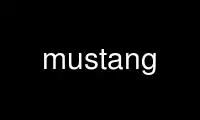
This is the command mustang that can be run in the OnWorks free hosting provider using one of our multiple free online workstations such as Ubuntu Online, Fedora Online, Windows online emulator or MAC OS online emulator
PROGRAM:
NAME
mustang - a multiple structural alignment algorithm
SYNOPSIS
mustang [options] files...
DESCRIPTION
This manual page documents briefly the mustang command.
Mustang is a program that implements an algorithm for structural alignment of multiple
protein structures. Given a set of PDB files, the program uses the spatial information in
the Calpha atoms of the set to produce a sequence alignment. Based on a progressive
pairwise heuristic the algorithm then proceeds through a number of refinement passes.
Mustang reports the multiple sequence alignment and the corresponding superposition of
structures.
To keep the command line short the user can write the path and file names into a
(description) file and supply the description file at the command line using the '-f'
option. For example see the file used to test the installation:
'/usr/share/doc/mustang/examples/test_zf-CCHH'.
PATH should have a prefix '>'. When the program parses this file, it looks for the line
starting with '>' symbol (whitespaces are ignored before and after the symbol). The PATH
containing the PDB files of the structures to be aligned should follow. See for example:
/usr/share/doc/mustang/examples/test_zf-CCHH'.
FILENAMES should have a prefix '+' (whitespaces are ignored before and after this symbol).
If PATH is specified then only the filenames should be provided after the '+' symbol.
However, if PATH line is NOT provided, then the absolute/relative paths of the structure
files should be provided.
The description file format is described further under the -f CmdLine option).
OPTIONS
A summary of options is included below.
-p <path>
Path to the directory holding the (PDB) structures to be aligned.
-i <struct-1> <struct-2>...
Input structures to be aligned. Note: if -p option is used in the command line,
supply only the file names of the structures; if not give the absolute/relative
path of each of the input structures.
-f <description file>
This option is used to AVOID entering the path (-p) and file name (-i) details in
the command line. Instead, to keep the command line short, the user can enter the
path and file name details in a "description" file and supply it in the command
line. The format of the "description file" is furher discussed in the
'DESCRIPTION' section above. Note: the options { -p , -i} and {-f} are mutually
exclusive.
-o <output identifier>
A common identifier for various outputs of the program. Appropriate extentions
(e.g. <identifier>.html, <identifier>.pdb, <identifier>.msf) will be added to this
identifier depending on the options the user specifies in the command line.
DEFAULT output identifier: 'results'
-F <format>
Alignment output format. The choices for <format> are: 'html', 'fasta', ´pir´,
'msf'. DEFAULT format: 'html'
-D [CA-CA diameter]
Produce an HTML file where the the residues are reported in lower case with grey
background when the aligned(superposed) CA-CA diamter of residues in a column of
alignment is > the CA-CA diameter threshold.
-s [<ON>/<OFF>]
Generate a PDB file containing optimal superposition of all the structures based on
the alignment. DEFAULT: 'ON'.
-r [<ON>/<OFF>]
Print to a file rmsd table of multiple superposition along with rotation matrix and
translation vector corresponding to each input structure. DEFAULT: 'OFF'.
--help display a help message and exits.
--version
output version information and exits.
AUTHORS
Mustang was written by A. S. Konagurthu, using the algorithm of A. S. Konagurthu et al.
(see REFERENCE)
MAN PAGE
This man page was originally produced by Morten Kjeldgaard ([email protected]) using the
information from Mustang's --help option.
REFERENCE
A. S. Konagurthu, J. Whisstock, P. J. Stuckey, and A. M. Lesk, MUSTANG: A multiple
structural alignment algorithm, Proteins, 64(3) 559-574 (2006).
BUG REPORT
arun AT csse DOT unimelb DOT edu DOT au
Use mustang online using onworks.net services
